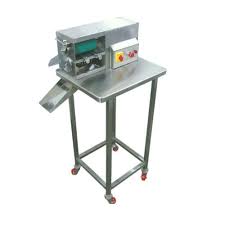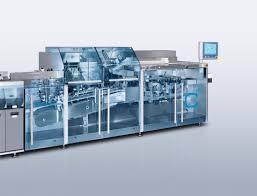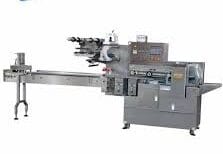|
Getting your Trinity Audio player ready... |
Deblistering Machine
Deblistering Machine: A deblistering machine is an essential piece of equipment in the pharmaceutical and nutraceutical industries, providing a vital function in the process of removing tablets, capsules, and soft gels from their blister packs. The deblistering process is crucial for several reasons, including repackaging, recycling, or disposal of products that no longer meet quality standards. Understanding the function, components, and various types of deblistering machines can help ensure the appropriate selection and maintenance of these devices for specific industry applications.
1. What is a Deblistering Machine?
A deblistering machine is a specialized device designed to remove tablets, capsules, or soft gels from their blister packaging. These machines are typically used in pharmaceutical, nutraceutical, and healthcare settings where blister packs contain products that may need to be salvaged for further processing, repackaging, or disposal. Blister packs are commonly used for packaging drugs, dietary supplements, and other capsules or tablets due to their protective nature and ability to extend product shelf life. However, when errors occur during production or packaging, deblistering machines are used to efficiently recover the products, ensuring minimal damage and maintaining the integrity of the product for further use or processing.
2. Reasons for Rejection of Blister Packs
Blister packs may be rejected for various reasons, including:
- Incorrect Products Inside the Blister Packs: If the wrong product is placed in the blister pack, it must be removed for quality control purposes.
- Changes in Inventory: If changes in inventory need to be made or a product is out of stock, it may require removing the tablets or capsules from the original blister packaging.
- Defective or Empty Products: Blister packs containing damaged or defective products, such as broken tablets, may be rejected.
- Incorrect Batch: If the batch number or expiration date does not match the product specifications, the blister pack may be rejected.
- Improper Printing or Labeling: If there are any issues with the labeling, printing, or visual defects on the blister pack itself, the pack may not meet regulatory standards.
3. Features to Look for in a Deblistering Machine
When choosing a deblistering machine, several features should be considered to ensure the machine is compatible with your needs:
Compliance with Regulatory Standards
A good deblistering machine must comply with the regulatory standards of the pharmaceutical industry, including:
- cGMP (current Good Manufacturing Practice): Ensures the machine operates in accordance with pharmaceutical manufacturing standards.
- CE Certification: Indicates that the machine meets European safety and health requirements.
- RoHS Compliance: Ensures that the machine adheres to environmental standards by restricting the use of hazardous materials.
Design and Construction
The design and construction of the deblistering machine are crucial for both performance and longevity. The machine should be:
- Ergonomically Designed: The machine should be easy to operate, with user-friendly interfaces, and designed for ease of maintenance.
- Made from Food-Grade Materials: Parts in direct contact with the tablets or capsules should be made from high-quality, food-grade materials, such as stainless steel, to prevent contamination.
- Durable and Stable: The construction should be rugged and able to withstand continuous use without compromising the stability of the operation.
Easy to Operate
The machine should feature a simple, intuitive interface, often with a touchscreen HMI (Human-Machine Interface) that allows operators to control the speed, settings, and operation of the machine easily.
High Recovery Rate
The deblistering machine should guarantee a high recovery rate of the products, ensuring that as much of the content as possible is successfully retrieved without damage.
Output Specifications
The machine should be capable of processing a sufficient number of blister packs per hour to meet production requirements. Typical output rates range from 1200 pieces per hour, but this can vary based on the model and design.
Advanced Technical Features
Modern deblistering machines come equipped with PLC (Programmable Logic Controllers), touchscreens, and advanced automation features to improve efficiency and monitoring capabilities.
4. Manual vs. Semi-Automatic Deblistering Machines
There are two main categories of deblistering machines: manual and semi-automatic.
Semi-Automatic Machines
Semi-automatic deblistering machines involve partial human intervention. These machines often include:
- Rotating Blades that cut through the blister pack material, efficiently extracting the products.
- Electric Motors and Rollers that help move blister packs through the machine.
- Electronic Counting Systems to keep track of the number of items processed.
- Waste and Product Separation Chutes to ensure that recovered products are collected separately from waste materials.
Semi-automatic machines strike a balance between human effort and automation, making them ideal for medium-scale production where speed and efficiency are important but human involvement is still required.
Manual Machines
Manual deblistering machines are the most labor-intensive. Operators must manually feed the blister packs into the machine and extract the products by operating levers or handles. These machines are typically used for small-scale production or situations where only occasional deblistering is needed. Though cheaper to purchase and install, they can be slow and physically demanding, which makes them unsuitable for large-scale operations.
5. Components of a Deblistering Machine
A deblistering machine consists of several components that work together to ensure a smooth and effective operation. These include:
- Set of Rollers: Rollers help transport the blister packs from one station to another, guided by electric drives and motors.
- Set of Chutes: One chute is designated for waste materials, while another is used to collect the recovered products.
- Metal Rollers and Rubber Wheels: These components work together to gently remove products from their blister packs, minimizing the risk of damage.
- Collection Box: This is where the recovered products are deposited for further processing.
- Touchscreen HMI Panel: This interface allows operators to adjust settings such as speed, spacing, and operation mode. It also enables monitoring of the machine’s performance.
- Structural Components: These provide stability and support to the entire machine, ensuring all parts are properly aligned and secure.
6. Benefits of Deblistering Machines
Deblistering machines offer several benefits for pharmaceutical and nutraceutical manufacturers:
- Time Efficiency: These machines remove tablets and capsules quickly, reducing processing time.
- Cost Reduction: By minimizing product wastage and ensuring safe recovery of products, deblistering machines help reduce overall operational costs.
- Ease of Operation: With user-friendly interfaces and automated features, these machines simplify the deblistering process.
- Regulatory Compliance: Most deblistering machines are designed to comply with strict industry standards, ensuring the products remain safe and uncontaminated.
- Quick Changeover: Deblistering machines are designed for fast setup and changeover, allowing for flexibility in handling various blister pack types.
7. Automatic vs. Semi-Automatic Deblistering Machines
An automatic deblistering machine operates with minimal human intervention, making it highly efficient for large-scale operations. These machines typically have programmable settings that allow them to handle various blister pack types without the need for manual adjustments. With automatic operation, the risk of human error is minimized, and the process is more streamlined.
In contrast, semi-automatic machines require some manual labor, making them more suited to medium-scale production or for tasks where human oversight is needed. While they may not offer the same level of automation, they still provide a significant increase in speed and efficiency compared to manual systems.
8. How Pharmaceutical Deblistering Works
Pharmaceutical deblistering machines follow a systematic process:
Step 1: Loading the Blister Packs
Blister packs are loaded into the machine, typically via an automatic feeding system that feeds the packs into the deblistering station.
Step 2: Positioning and Clamping
The deblistering machine adjusts the blister packs to ensure they are properly aligned for deblistering. The machine uses tools to clamp and hold the blister packs in place, ensuring that they do not shift during the removal process.
Step 3: Removal of Products
The machine uses mechanical or pneumatic force to gently press the tablets, capsules, or soft gels out of the blister pack, transferring them to a collection bin. At the same time, the empty blister pack is discarded or collected separately.
9. Industries That Use Deblistering Machines
Deblistering machines are used across various industries, including:
- Pharmaceuticals: Pharmaceutical companies use deblistering machines to handle packaging errors or when products need to be repurposed for different applications.
- Nutraceuticals: These machines are used in the nutraceutical industry to remove dietary supplements and other products from blister packs.
- Healthcare Providers and Hospitals: Hospitals and pharmacies use deblistering machines to break down and manage pill packs, ensuring accurate dispensing of medication.
10. Maintenance and Troubleshooting
Proper maintenance is essential for the long-term operation and efficiency of a deblistering machine. Regular inspections, including checking for wear on rollers, blades, and electrical systems, help ensure the machine runs smoothly.
Common troubleshooting issues may include:
- Motor Issues: If the motor fails to operate, it could be due to issues with the electrical connection or internal components.
- Pill Damage: Misalignment or excessive speed may result in damaged pills, requiring adjustments to machine settings.
Conclusion
Deblistering machines are invaluable tools in the pharmaceutical and nutraceutical industries, streamlining the process of removing capsules, tablets, and soft gels from blister packs for further processing, repackaging, or disposal. These machines vary in terms of automation and design but share common features that ensure efficiency, safety, and compliance with industry standards. Whether used in large-scale production or smaller operations, deblistering machines contribute significantly to cost savings, improved product recovery rates, and regulatory compliance across various industries.















